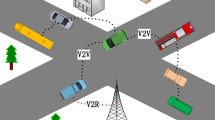Abstract
In view of the problem that the channel resources cannot be allocated optimally in Vehicular Ad Hoc NETwork (VANET) with nodes sending information at fixed power, we propose an adaptive VANET power control algorithm. The algorithm calculates the vehicle’s position prediction error, dynamically adjusts the transmission power according to different error sizes, and then optimizes channel resource allocation and node routing performance. The experimental results show that our algorithm can adaptively adjust the transmission power, reduce the channel occupancy rate and increase the data packet delivery rate, so that the information transmission between vehicles becomes more effective.
Access this chapter
Tax calculation will be finalised at checkout
Purchases are for personal use only
Similar content being viewed by others
References
Torrent-Moreno, M., Santi, P., Hartenstein, H.: Distributed fair transmit power adjustment for vehicular ad hoc networks. In: 2006 IEEE Communications Society on Sensor & Ad Hoc Communications & [2] Networks, Secon IEEE (2006)
Egea-Lopez, E.: Fair distributed congestion control with transmit power for vehicular networks. In: IEEE International Symposium on a World of Wireless. IEEE (2016)
Fallah, Y.P., Nasiriani, N., Krishnan, H.: Stable and fair power control in vehicle safety networks. IEEE Trans. Veh. Technol. 65(3), 1662–1675 (2016)
Mittag, J., Schmidt-Eisenlohr, F., Killat, M., Härri, J., Hartenstein, H.: Analysis and design of effective and low-overhead transmission power control for VANETs. In: Proceedings of the Fifth ACM International Workshop on VehiculAr Inter-NETworking - VANET 2008 (2008). https://doi.org/10.1145/1410043.1410051
Hu, R.N., Guo, A.H.: Transmission reliability algorithm based on power control in Internet of vehicles. Comput. Appl. 35(6), 1523–1526 (2015)
Zuo, Y.X., Guo, A.H., Huang, B., Wang, L.: Power control algorithm based on network utility maximization in Internet of vehicles, 37(12), 3345–3350 + 3380 (2017)
A safety collision avoidance algorithm based on comprehensive characteristics. Complexity 2020, Article ID 1616420, 13 p. (2020). https://doi.org/10.1155/2020/1616420
Liu, M.J., Tan, G.Z., Li, S.B., et al.: Adaptive message sending rate control method based on channel congestion cost calculation in VANET. J. Commun. 037(10), 108–116
Mo, Y.F., Yu, D.X., Bao, S.N., et al.: Beacon transmission power control algorithm based on the preset threshold in VANETs. J. Northeast. Univ.: Nat. Sci. Ed. 38, 334 (2017)
Xu, Z.X., Li, S.J., Lin, X., Wu, Y.: Power control mechanism for vehicle status message in VANET. Comput. Appl. 36(08), 2175–2180 (2016)
Killat, M., Hartenstein, H.: An empirical model for probability of packet reception in vehicular ad hoc networks. Eurasip J. Wirel. Commun. Netw. 2009(1), 1–12 (2009). https://doi.org/10.1155/2009/721301
Kloiber, B., Härri, J., Strang, T.: Dice the TX power - improving awareness quality in VANETs by random transmit power selection. In: IEEE Vehicular Networking Conference. IEEE (2012)
Zhang, Y., Wang, M., et al.: Research on adaptive beacon message broadcasting cycle based on vehicle driving stability. Int. J. Netw. Manag. (2020). https://doi.org/10.1002/nem.2091
Author information
Authors and Affiliations
Corresponding author
Editor information
Editors and Affiliations
Rights and permissions
Copyright information
© 2020 Springer Nature Switzerland AG
About this paper
Cite this paper
Wang, M., Yin, G., Du, F., Wang, J., Zhang, Y. (2020). Research on Adaptive Beacon Transmitting Power Based on Vehicle Forecast Error. In: Chen, X., Yan, H., Yan, Q., Zhang, X. (eds) Machine Learning for Cyber Security. ML4CS 2020. Lecture Notes in Computer Science(), vol 12487. Springer, Cham. https://doi.org/10.1007/978-3-030-62460-6_8
Download citation
DOI: https://doi.org/10.1007/978-3-030-62460-6_8
Published:
Publisher Name: Springer, Cham
Print ISBN: 978-3-030-62459-0
Online ISBN: 978-3-030-62460-6
eBook Packages: Computer ScienceComputer Science (R0)




